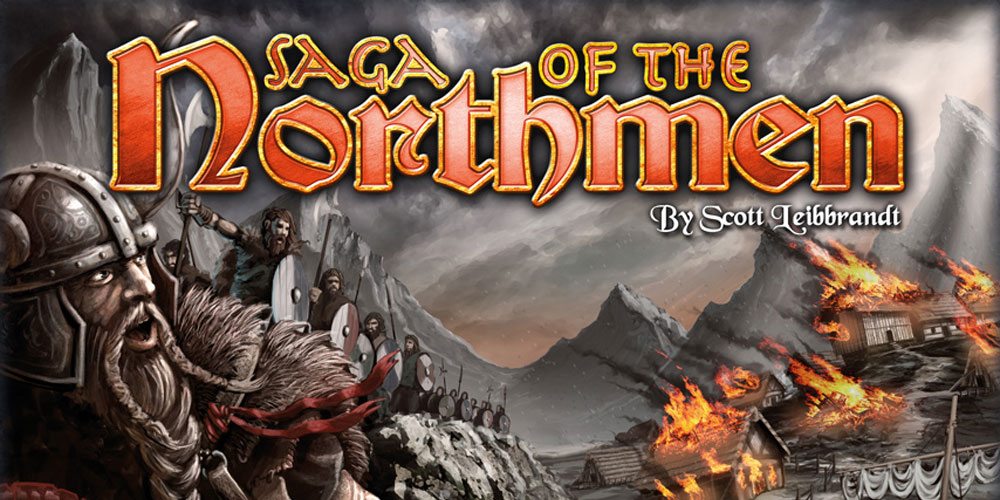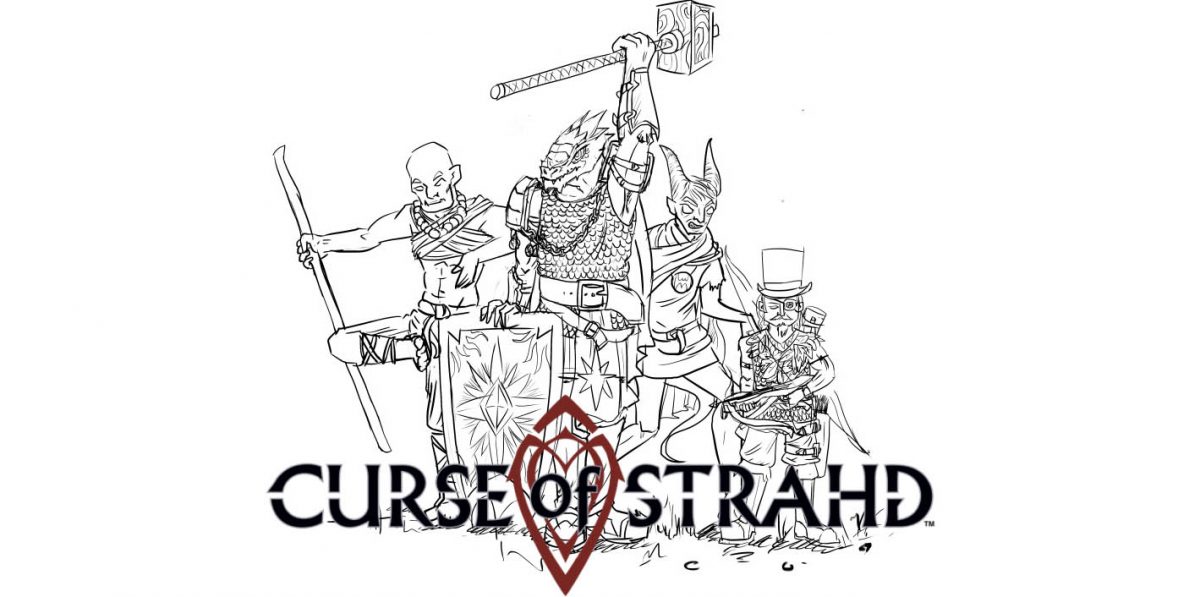In the Marvel Empyre event that began in 2020, the Avengers and the Fantastic Four team up to take on a combined Kree and Skrull fleet that is on its way to destroy the Earth. It turns out that the real target of the Kree and Skrull is the animated plant beings known as the Cotati. When all realize they face the same threat, can these superheroes work together to save the Earth and humanity? This epic battle can now take place on your gaming table, or any horizontal surface, with the Marvel HeroClix: Avengers Fantastic Four Empyre Miniatures Game.
What Is the Marvel HeroClix: Avengers Fantastic Four Empyre Miniatures Game?
The Marvel HeroClix: Avengers Fantastic Four Empyre Miniatures Game is a tabletop tactical combat game for 2 players, ages 14 and up, and takes about 30-45 minutes to play. It’s currently available for preorder at your FLGS as well as online from retailers such as Amazon and has a suggested retail price of $49.99 for a copy of the game. It can be played as a standalone game or combined with other HeroClix figures.
The Marvel HeroClix: Avengers Fantastic Four Empyre Miniatures Game was designed by Scott D’Agnostino, Kennie Pena, and James O’Brien and published by WizKids, with graphic design by Patricia Rodriquez, Mark Shabunia, and Daniel Solis.
The Marvel HeroClix: Avengers Fantastic Four Empyre Miniatures Game Components
Here is what you get in the box:
- 10 HeroClix Pre-Painted Miniatures
- 20 Character Cards
- 32 Action, Object, and Terrain Tokens
- 6 Full-Color Double-Sided Map Tiles
- 2 Special Edition Avengers/Fantastic Four six-sided dice
- 2 Full-color Powers and Abilities Cards (2021 edition)
- 1 Full-Color HeroClix Core Rulebook (2021 edition)
- 8 Scenario Cards
- 12 Scenario Bystander Tokens
- 2 Scenario Object Tokens
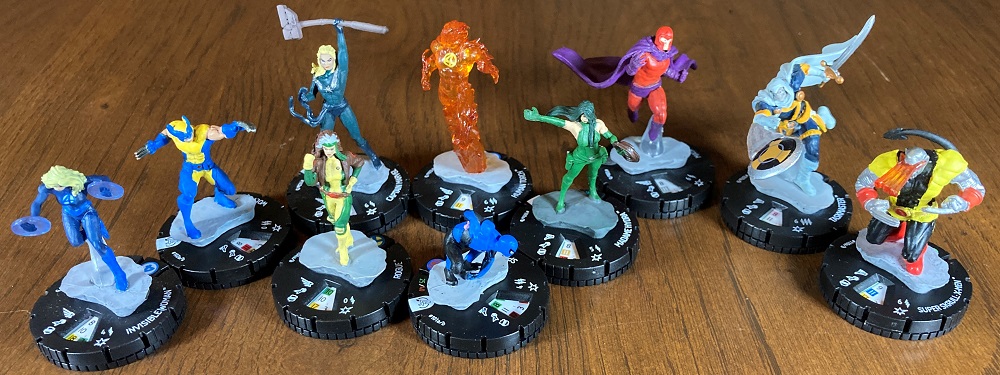
The ten miniatures come pre-painted and include Captain Marvel, Spider-Man, Invisible Woman, Wolverine, Human Torch, Rogue, Madame Hydra, Magneto, Taskmaster, and Super Skrull: X-Men. each miniature is mounted on a HeroClix dial base with all of the character’s stats and values.
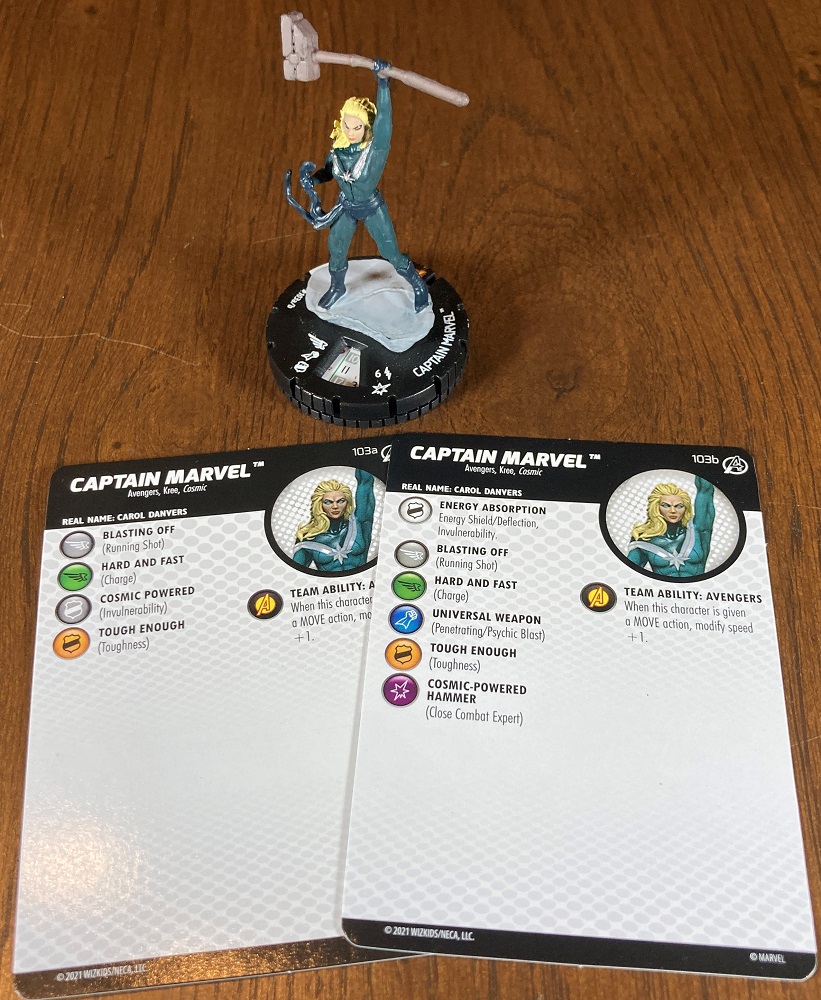
Each of the ten characters comes with two character cards. One is for the basic abilities and the other for the advanced abilities. The basic abilities are best for players new the game while they are learning. Once they understand the game system better, the advanced abilities allow for more complex powers. These cards also list the point value for that character and show all of the dial values in a table.
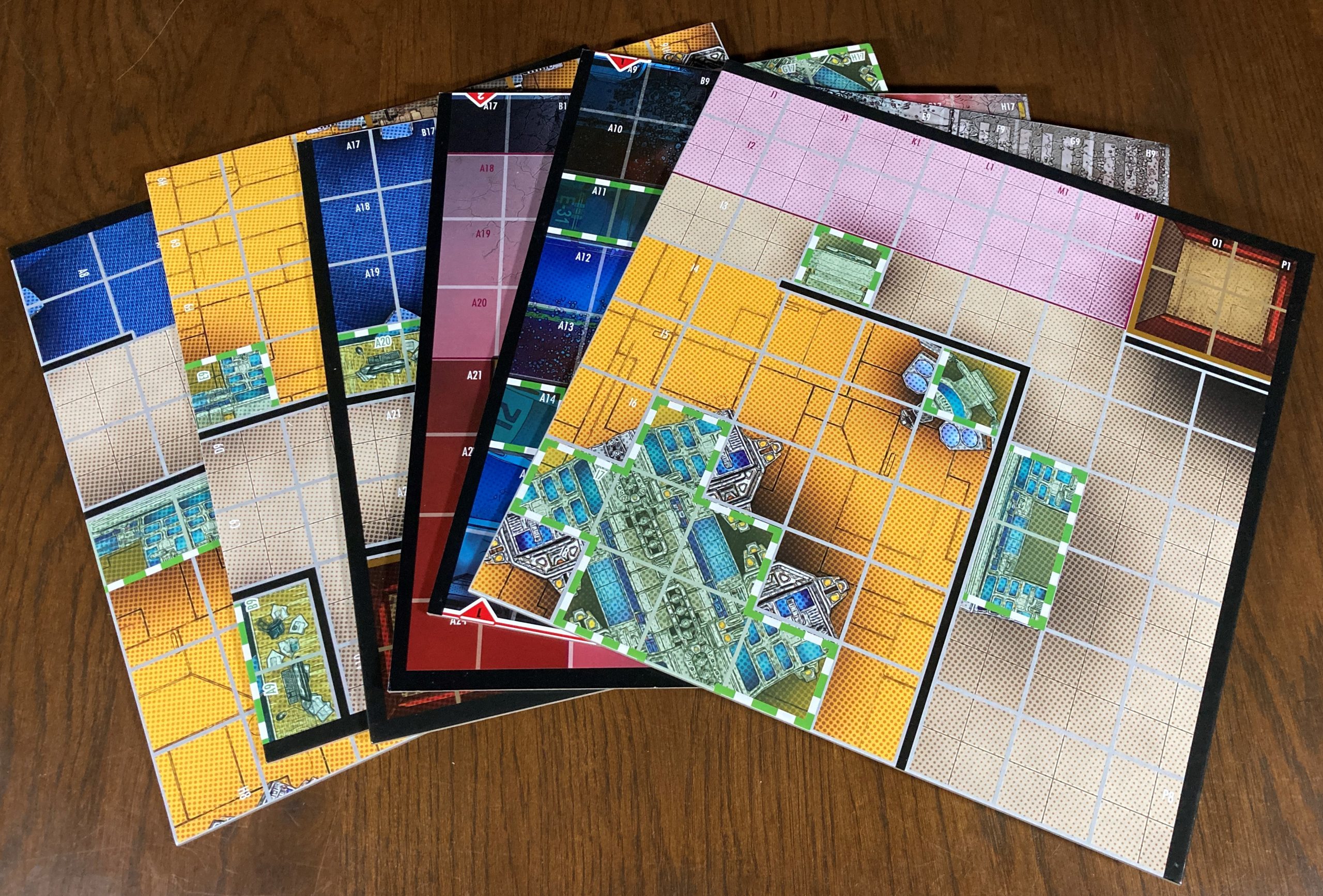
The six map tiles are double-sided and allow you to create two different maps. One is an outside map of New York City and the other map is of the inside of the Baxter Building, the headquarters of the Fantastic Four. These tiles are thick cardboard and will not have creases like paper maps.

The game comes with a variety of tokens. Some are used to show actions while others designate rubble or smoke on the map. Small and large objects are also represented by tokens.

There are even some bystander tokens that provide additional characters for you to use during gameplay. These have all the stats of a character but are KOed if they take any damage.
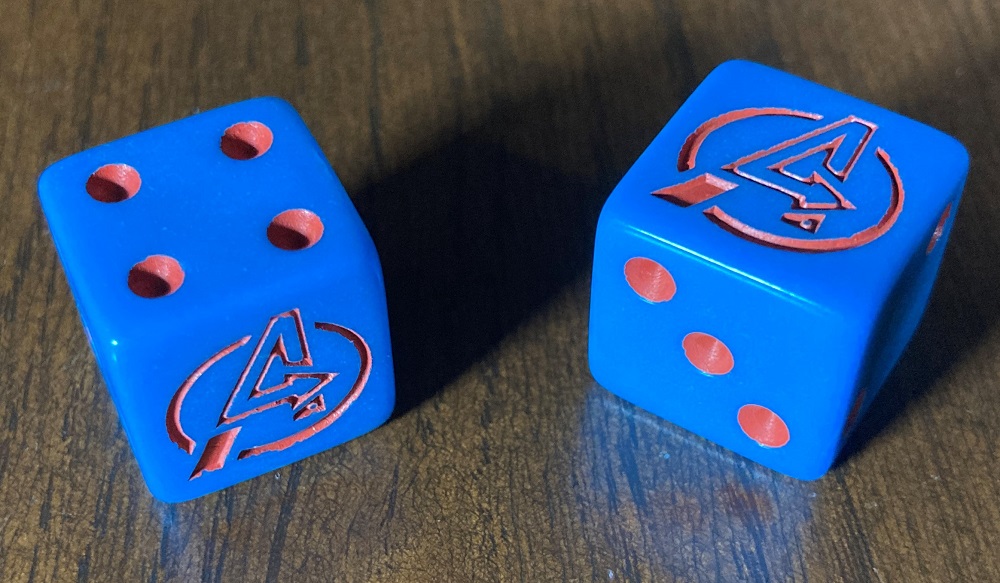
These two dice are custom-made for the Marven HeroClix Empyre series. The six-side of the dice feature the Avengers/Fantastic Four logo.
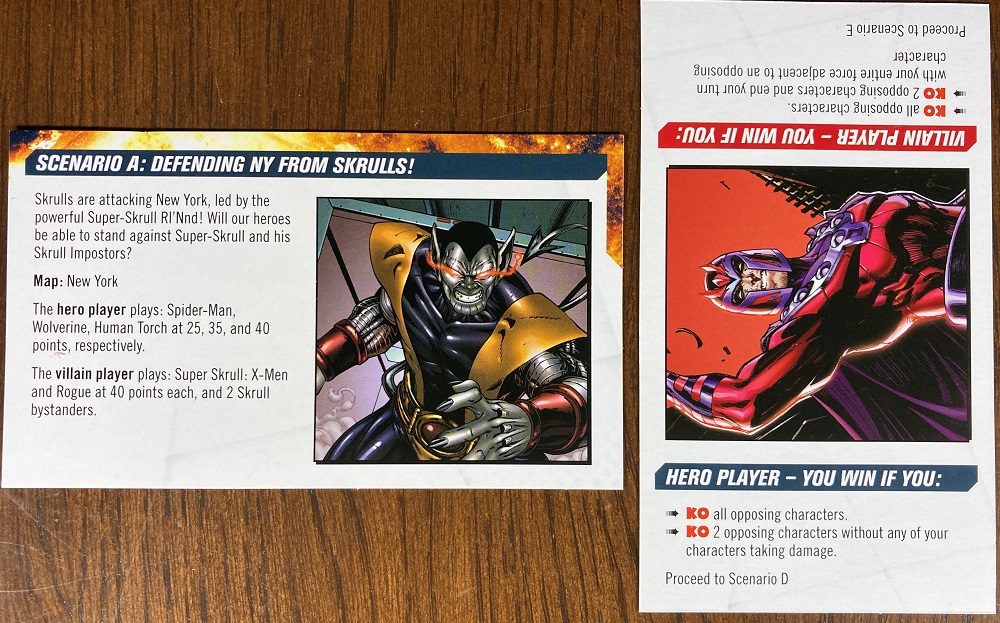
The 8 scenario cards are labeled A-H and let you play through a series of battles that tell the story of the Empyre conflict. One side of the card tells the story for the current scenario and describes the setup for the battle. The other side lists the objectives for the Heroes and the Villains. The results of one scenario direct you which scenario to play next.
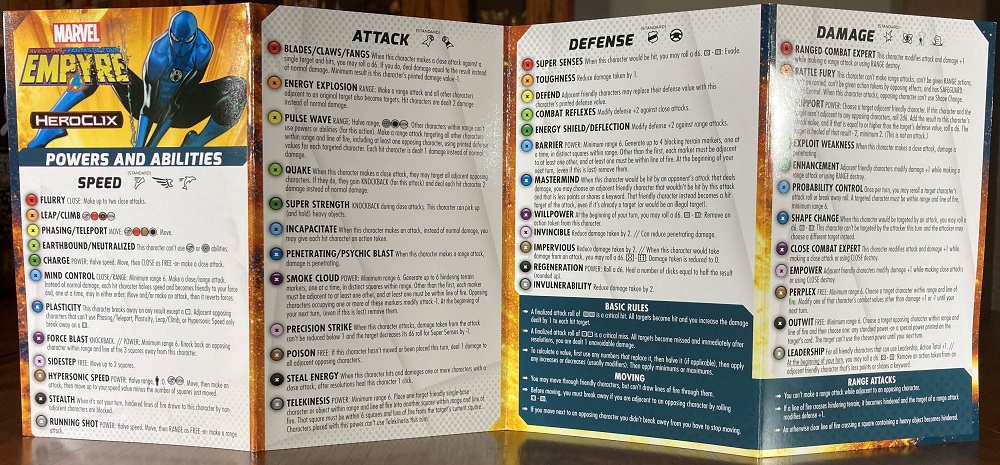
There are two Power and Ability cards which list all of these features available in the game. They serve as a quick reference on how these power and abilities are used in the game. The basics of the rules are also included on these cards so players don’t have to continuously refer to the rulebook.
How to Play the Marvel HeroClix: Avengers Fantastic Four Empyre Miniatures Game
The Goal
The goal of the game is to defeat the opposing team by completing the scenario objectives.
Setup
Before you begin setting up, select a scenario card. If this is your first game, select scenario card A. For subsequent games, who wins the current scenario determines which scenario to play next. After a scenario is chosen, decide who will play as the heroes and who will take the role of the villains. Collect the characters and the corresponding character cards as listed on the scenario card and turn the characters to their basic dial starting click by turning the dial to click number 1 and the green starting line. Each player then rolls two dice. The one with the highest roll is the first player and the other person is the second player.
Assemble the maps tiles together to create the map called for on the scenario card. The second player chooses which starting area they want. Then the first player places their team of characters in the starting area followed by the second player. Place supplies of action and other tokens in easy reach of each player. Turn the scenario card over to the side with the win conditions and position it so that the hero and villain victory conditions are facing each respective player. Be sure to give each player a Powers and Abilities card for quick reference. You are now ready to start the game. Check for any effects that happen at the start of the game and then the first player takes the first turn.

Gameplay
The game is played with each player alternating turns. Each turn is divided into four phases. At the beginning of the turn phase, resolve any effects that may trigger or end during the beginning of a turn. The action phase comes next. Here the active player may take up to three actions and as many free actions as they wish. The third phase is the end of turn phase, and here any effects for the end of the turn are resolved. Finally, the clear phase lets you clear or remove all action tokens from all of the current player’s characters that did not receive an action token in this turn.
Actions
The majority of each turn is spent on the action phase, so let’s discuss that now. During a turn, a player can assign up to three actions to three different characters. A character can only perform one action per turn. There are three basic actions. First, a character can move a number of spaces equal to its speed value on their dial. Movement can be both orthogonal as well as diagonal. A player can perform a close attack as an action against an opposing character in one of the eight spaces surrounding the character. If the character has the ability to do ranged attacks, that is the third type of basic action. To make a ranged attack, check the range of the character on the dial and then count the spaces between the character and the target. As long as another character is not in the way and terrain does not block line of sight, the ranged attack can be made.
Since we are playing with superheroes, many of the characters have powers they can use as an action instead of one of the three basic actions. The Powers and Abilities card shows all of the abilities available in the game. Some, such as Charge, have the keyword POWER in their description. In the case of Charge, the character can move half of their speed and then make a close attack. Some characters have free abilities. These can be used without counting as an action, but a free action can only be used once per turn. However, different free actions can be performed within the same turn.
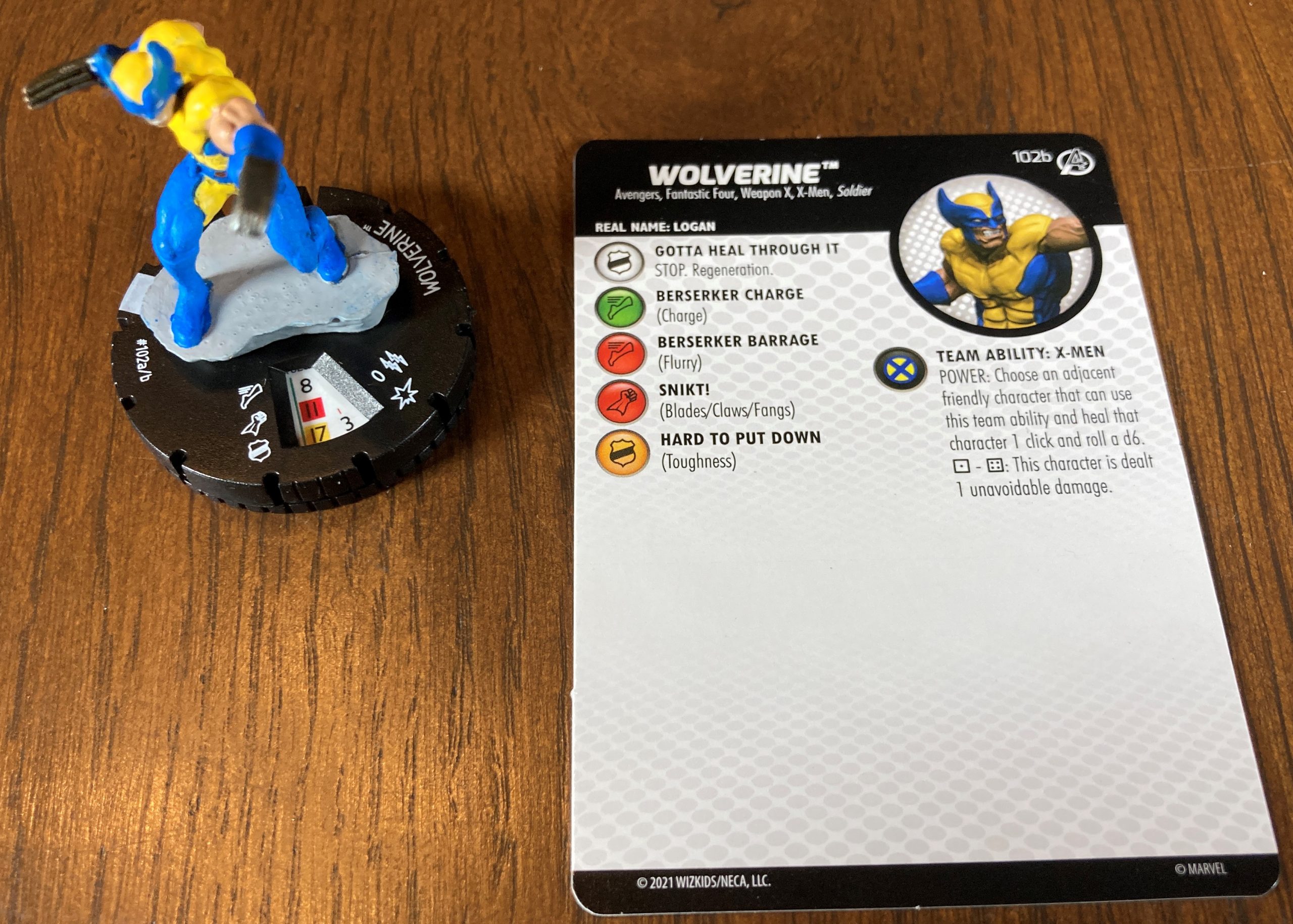
After a character has performed an action, place an action token next to them. If a character performed an action during the previous turn, you can perform an action during the subsequent turn. This will place a second action token next to them. This is called pushing. In the next turn, you are not able to use that character. They must rest so they can remove the action tokens at the end of the turn in which they did not receive an action token.
Combat
Once you have decided to perform either a close or ranged attack, it is time to resolve the combat. Start off by determining the target. Characters will have one or more bolt icons next to their range value. Each bolt represents a target they may attack. You cannot target the same character more than once during an attack. Now determine if you hit the target. Roll two dice and add the result to the attacking character’s attack value. Compare this total to the defender’s defense value. If the total is equal to or greater than the defense value, the target is hit. Otherwise, the attack fails and the target was missed. Use the same dice roll for all targets, but compare the results to each target’s individual defense value. If the attacker rolls double sixes, this is a critical hit. If the target is hit, it receives 1 extra damage. On the other hand, if double ones are rolled, snake eyes, then it is a critical miss. The attack automatically misses and the attacker takes one unavoidable damage.
The attacking character deals damage equal to its damage value. If there are multiple targets that are hit, the attacker decides how to divide up the damage. Characters that are hit may have powers that modify the damage. Captain Marvel’s Tough Enough ability lets her reduce the damage she takes by one. After the damage is determined, hit the character, then rotate their dials one click for each damage so that the click number on the dial increases. If “KO” appears in the dial, the character is KOed and removed from the game. Finally, check to see if the target is knocked back. If the attacking character has the Knockback ability, or the dice roll was doubles, except for double ones, the attacking player can move the target up to 3 spaces away from the character that hit them.
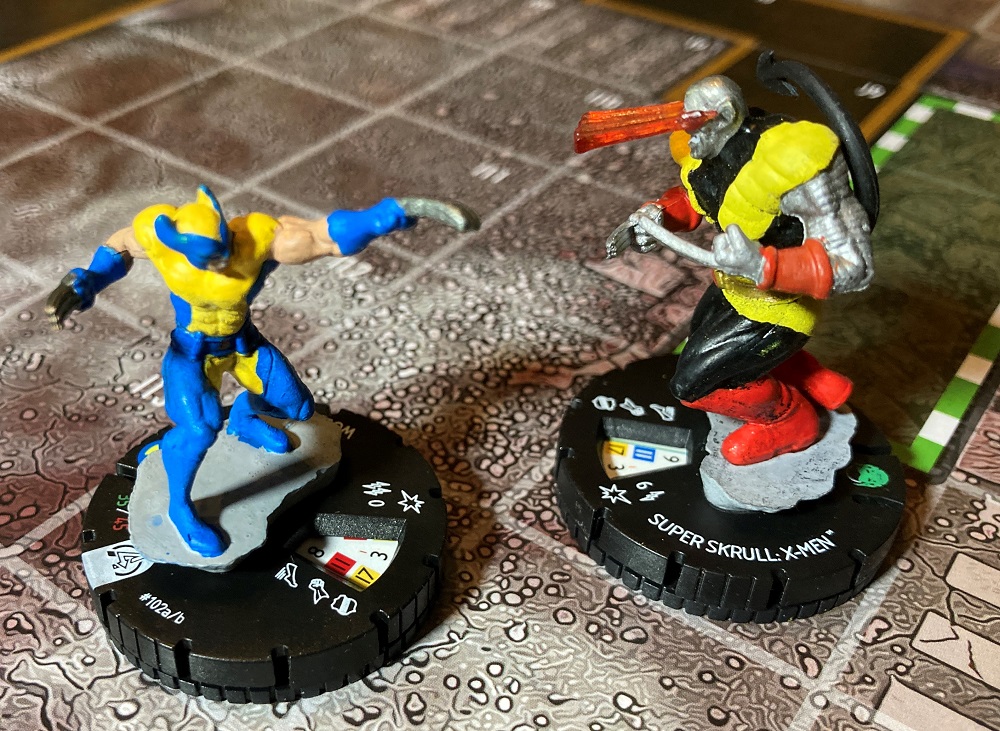
Game End
The game ends when the scenario objectives for either the Heroes or Villains have been met. In most cases, it involves when all or a certain number of opposing characters have been KO’d.
Why You Should Play the Marvel HeroClix: Avengers Fantastic Four Empyre Miniatures Game
I first played Marvel HeroClix when it first came out in 2002. It used the same clicking dial base as WizKids Mage Knight miniatures wargame, which I had played a bit. As I stayed busy with young children and a new job, I stopped playing and my small collection of heroes and villains went onto a shelf. As I would frequent my FLGS, I would see new series of HeroClix released but felt overwhelmed by the sheer number of figures available. Plus, while I had occasionally read some comics, I did not know who most of the characters were. Now, thanks to the Marvel Cinematic Universe and the Marvel series on Disney+, my children and I are big Marvel fans. My son and I even enjoy the digital comics we read on Marvel Unlimited. When I saw that WizKids was releasing a stand-alone miniatures game featuring the Empyre storyline, which I had just recently read, I wanted to try it out and introduce HeroClix to my children. I am glad I did.
First off, while I love playing games with miniatures, I have neither the patience nor the talent to assemble and paint miniatures. Therefore, I appreciate that the miniatures in this game come pre-painted—and they look good too! Second, all the information you need to play a game is right on the dials of the characters. You can quickly see how far they can move, their attack and defense values, and so forth. Colors on the dials represent their powers and abilities. As they take damage or heal, just click the dial and some of the values, powers, and abilities change. No need for record-keeping or character sheets. All of the info is on the dial under the miniature. I like the addition of character cards that list the specific powers and abilities customized for that character. For example, Spider-Man has the Web Ball ability which is his version of incapacitate. The Swinging In power is Spidey’s Charge power. These cards also help new players learn the game and how to play as each of these heroes and villains. Due to the fact that so much of the game is built into the miniatures, a lot of tokens and other means of keeping track of info is not necessary to set up a game is quick. In fact, after opening the box and deciding on a game, you can be playing in a matter of minutes.
I like how the Marvel HeroClix: Avengers Fantastic Four Empyre Miniatures Game comes as a standalone game that is ready to play right out of the box. It has some durable map tiles that are so much better than paper maps that fold up and have creases when you play with them. Plus the maps have square spaces so you can count distance for movement or ranged attacks rather than having to get out a ruler or measuring tape like some miniatures games. The scenario cards are a great way to play the game. They tell you everything you need to set up and play a game and add a storyline so you have some context on why you are fighting each other. This provides an excellent method for introducing new players to the HeroClix system, especially since the scenarios use the basic abilities of the characters. While the suggested age is 14 years and up, that is for learning to play on your own. Younger children could play, especially with the basic abilities, as long as an adult or older child is there to help them learn how to play.
I am very impressed with the Marvel HeroClix: Avengers Fantastic Four Empyre Miniatures Game. The rules are fairly simple and straightforward, making this a quick game to learn, and after a brief introduction, it can literally be taught to others while you play. Since each character has a few powers and abilities, players can concentrate on just those specific to their characters and not have to master all of the powers and abilities available in the system. The basic and advanced dials all built into each character allows players to take the game to the next level without having to change anything. You can use the same game to play with your younger children as well as your experienced game group. Furthermore, once you get into the game, you can easily expand it with HeroClix booster packs, which each contain a random assortment of five miniatures. If you are a fan of Marvel stories and characters and interested in an easy-to-learn miniatures system that requires no assembly or painting, then I highly recommend the Marvel HeroClix: Avengers Fantastic Four Empyre Miniatures Game.
For more information, visit the Marvel HeroClix: Avengers Fantastic Four Empyre page!
Click here to see all our tabletop game reviews.
![]() To subscribe to GeekDad’s tabletop gaming coverage, please copy this link and add it to your RSS reader.
To subscribe to GeekDad’s tabletop gaming coverage, please copy this link and add it to your RSS reader.
Disclosure: GeekDad received a copy of this game for review purposes.



